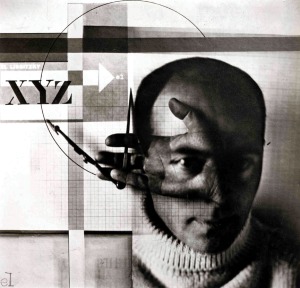Art before the early 1920’s was “old-fashioned” compared to new art movements called Constructivism. This type of art was said to be the future of art. This type of art contained new tools, new style and artists who wanted to move forward. The main goal of this art was to spring the people of Russia into the future. Many artists began to create interesting art without the use of paint. One of these artists was EL Lissitzky.
El Lissitzky created numerous amounts of constructivist art in the early 1920’s. One of his most popular pieces of art is “The Constructor” made in 1924. This piece of art was very interesting. It was a self-portrait. This piece of art was different from works in the past before this movement; it is a photomontage that used geometric shapes to complete it. This art was a dramatic change from previous arts of the past. The color of the image is in black, grey, and white. The artist uses a white background to make his face the center of attention. The glare on his face gives an ominous feeling. Along with the glare is also a hand that comes across his face holding a compass. Also in this image are the letters in XYZ in bold print. The image is very clear. Every line is sharp and precise. One line that really stands out is the in the picture is the circle. It almost makes a whole circle until it gets to his head. This image is very interesting, however what does this picture mean?
In art there can be many various meaning that contribute to the story of that artwork. In El Lissitzky’s piece “The Constructor.” We see that Lissitzky uses himself as the center of attention. His picture’s background contains very distinct lines. This represents how Lissitzky thought of himself, a perfectionist. “Self-portrait as a mere reflection of the artist’s inner self.” 1 Along with this we see a compass that is in his hands. At this time Russia became more revolutionary. Machines were beginning to process in mass and the people around the machines became accustom to them. Lissitzky is also influenced by machine which contributes to the perfect lines of the artwork. Lissitzky states:
“We have had enough perpetually hearing MACHINE MACHINE MACHINE MACHINE. In the repetition of the word MACHINE, we read the modern artist’s ambivalent relationship to mechanical reproduction: on the one hand, the rigorous linear order and uniform application of ink presented by the thrice-repeated type written line celebrates sterility; and on the other hand the content of the sentence itself bemoans the transformation of the industrial paradigm into an aesthetic cliché.”1
Machines had become a part of everyday life which pushed forward Constructivist art. Many arts like Lissitzky’s were made in black, white, and grey. Like the typical machine, grey was the color that most constructivist art shared. The machines were the revolution that El Lissitzky makes relevant with the circle that goes in the middle of his art work. The point of constructivist art was to push forward from the past. In his picture the circles represent that movement. The ability to mass produce is revolutionary. Along with that we see the letter “XYZ.” These letters idealize that this is the end of previous art work. “XYZ” leads into the revolutionary circle symbolizing that new constructivist art is the future.
The title of this art work “The Constructor” is an excellent selection for the constructivist painting. In a way he seems to be a hero fighting for this art. The Constructor, as Lissitzky calls himself in the portrait, is fighting against all that is “old fashioned.” The use of the compass, geometric shapes, machine color gives a different view of art and of the artist. El Lissitzky’s goal for constructivist art was to revolutionize the style of art so that constructivist art work is so amazing that it diminishes the past old-fashioned art.
Bibliography
(1)Pau.l Galvez Self-Portrait of the Artist as a Monkey-HandOctober , Vol. 93, (Summer, 2000), pp. 109-137 Published by: The MIT Press http://www.jstor.org/stable/779159
